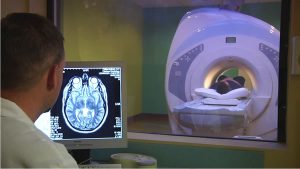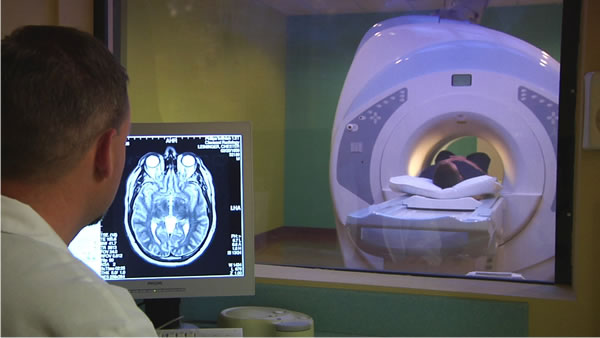10 MRI Technologists’ Rules for MRI Safety
Technologists, radiologists, and facility staff all work hard to ensure MRI safety for every patient they treat. Still, some patients get nervous at the prospect of having their first-ever MRI scan.
Really, diagnostic imaging’s reputation for risk comes from X-rays, which expose patients to a minimal amount of ionizing radiation. Despite this, X-rays are generally safe — and if a doctor orders an imaging procedure, the patient should always comply. Medical professionals weigh the risk versus the benefit before ordering any intervention.
But X-rays are one thing. MRI scans don’t expose patients to any radiation at all. They’re extremely safe. The machinery can be intimidating — people don’t tend to relish the idea of sliding into a narrow tube that looks like something out of a Star Trek episode — but the scan itself is harmless, and the resulting images save lives every day.

If you or a loved one are about to get your first MRI scan, and you’re feeling nervous about it, we thought a few safety rules that your technologists and radiologists will follow will make you feel better. Health care professionals are trained to keep patients safe above all else, and they make sure to minimize the already-infinitesimal risks involved with MRI scans by observing important safety rules. Here are a few of the practices that imaging professionals will use to keep you safe and comfortable during your MRI scan:
- They will ensure that you don’t have any metal devices or implants on your person.
MRI scans create a strong magnetic field around the patient. That’s not dangerous in itself, but it does become important to ensure that no ferromagnetic metals enter the scanning room. Even nonmagnetic metals can interfere with the magnetic field, or heat up and cause burns. Facility staff screen patients for any type of metal, including that found in medical implants such as aneurysm clips.
- If you do have implanted medical devices, they will insure that they are safe for the scan before you get anywhere near the imaging suite.
Medical implants are designated as MR Conditional, MR Safe, or MR Unsafe. Your health team will check the rating of any medical implants you have, compare the specs to those of the scanner they’ll be using, and determine whether the scan is safe to proceed.
- They will double-check every object that enters the scan room for MRI safety.
The working assumption is that anything imaging staff don’t have a record of is MR Unsafe. The screening process can be quite involved, but it’s also fairly quick.
- They will ask you to change out of your clothes and into a facility-provided, MR-safe gown.
Even the small amount of metal embedded in many items of clothing can heat up dangerously, or disrupt scans. The safest option is to ask patients to change into an MR-safe gown.
- They will help you lie in the MRI machine in a way that avoids skin-to-skin contact.
MRI scanners use blasts of electromagnetic radiofrequency waves to create images of the body. This energy is generally safe, although if patients maintain skin-to-skin contact during the scan, they could create a conducting circuit at the point of contact. Current might heat up the skin, causing burns. That’s why MRI technicians are always careful to help patients find a comfortable posture that doesn’t involve any skin-to-skin contact. They may provide insulating pads for this purpose.

- They will route all equipment cables straight outwards from the machine, and won’t allow them to touch each other or the patient.
Imaging technicians are extremely careful with all electrically conductive materials, including cables that are part of the scanning process. Cables that are too close to another conductor — including the patient’s skin — can transfer energy through capacitive coupling, so staff route cables very carefully.
- They will provide padding and blankets that are certified MRI-safe.
Patient comfort is second only to patient safety. Still, it’s important to ensure that everything entering the MRI suite is MR-safe. Imaging facilities stock comfortable blankets and nonconductive padding to ensure patient comfort during the scan.
- They will always use the lowest amount of radiofrequency power sufficient to obtain a clear image — a measurement known as the Specific Absorption Rate, or SAR.
The SAR is a measurement of radiofrequency energy that passes through the patient’s body during an MRI scan. Higher levels can cause electrical conduction in the patient’s tissues, causing heat. If this goes on long enough, it can lead to burns. However, technologists always use the lowest possible SAR for a given scan, generally preventing dangerous warming.
- They will remain in constant communication with patients throughout the entire scan.
The most powerful tool to prevent injury during MRI scans is patient self-reporting. Technologists keep lines of communication open with patients throughout the entire process. That way, if a patient starts to feel uncomfortable, or feels skin heating up, they can report to the technologist, who will halt the scan until they address the situation.
- They will monitor patients during the scan with video and audio signals inside the machine’s bore.

Imaging staff won’t just wait for patients to tell them if they experience discomfort. They also carefully monitor their patients, watching for signs of distress. At the first sign of concern, technologists will pause the scan and make sure the patient’s safe and comfortable.
MRI Safety Along Every Dimension
These safety rules come courtesy of the U.S. Food and Drug Administration and the Section for Magnetic Resonance Technologists. This ensures that each tip has been tested, retested, and verified before being added to the list of best practices. The FDA and the SMRT both follow evidence-based science to make their recommendations.
Of course, there is one hazard to a diagnostic imaging procedure that neither the FDA nor SMRT can prevent: Overcharging. Hospitals often charge exorbitant fees for MRI scans.
Luckily, the FDA and SMRT aren’t the only ones looking out for patients. Independent imaging centers, such as those in the BestPriceMRI.com network, commit themselves to offering the highest-quality MRI scans at the lowest-possible prices. They are able to do this because they are specialists; hospitals have to create enough revenue to cover enormous facilities, multiple specialized departments, and hundreds or even thousands of employees.
The diagnostic imaging centers you’ll find on BestPriceMRI.com follow lean business practices to keep prices to an absolute minimum. At the same time, they only employ certified, industry-leading radiologists — the same ones hospitals use — and state-of-the-art equipment. It’s a high initial expense, but once the newest, best MRI scanner is installed in a facility, BestPriceMRI.com facilities are able to stay solvent through the steady stream of business that comes from quick, convenient appointments, doctor-preferred results, and excellent patient care.
Trust your technicians and radiologists to keep you safe during your next MRI scan. And trust BestPriceMRI.com to get you the lowest price you’ll find, along with a convenient location and a time of your choosing — even on evenings and weekends, if you prefer.
Contact BestPriceMRI.com at 888-322-7785 to make your appointment today.
References:
“Magnetic Resonance Imaging (MRI) Safety.” RadiologyInfo. Radiological Society of North America, Inc., 5 Apr. 2017. Web. 1 Sept. 2017.
“Magnetic Resonance Imaging: Tips for Scanning Patients with Implants.” FDA. U.S. Food and Drug Administration, Section for Magnetic Resonance Technologists, n.d. PDF. 1 Sept. 2017.
“MRI Burn Prevention: Tips for Keeping Patients Safe.” FDA. U.S. Food and Drug Administration, Section for Magnetic Resonance Technologists, n.d. PDF. 1 Sept. 2017.

